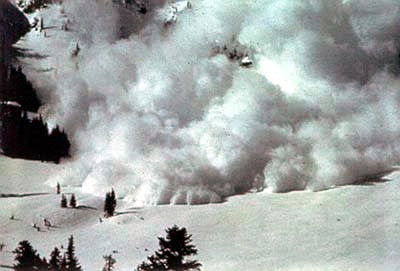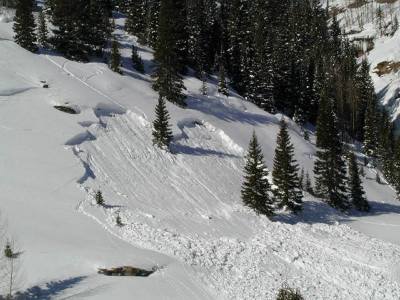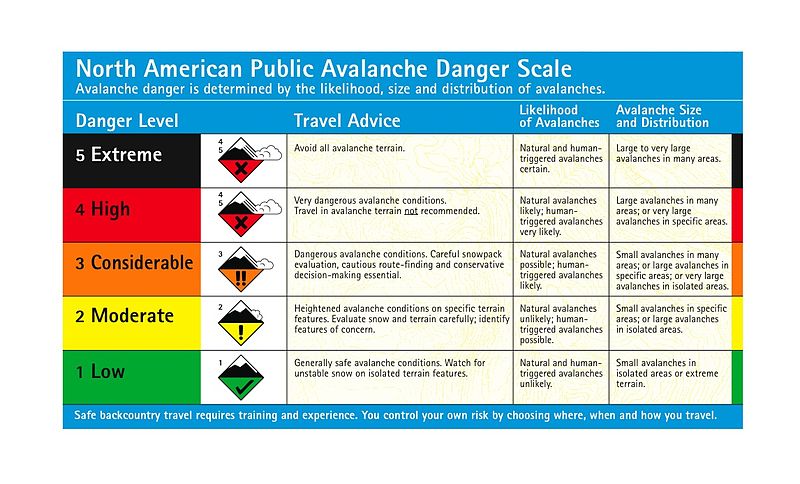If you ever wondered what it’s like to be swept up in a snow avalanche, watch this 9 minute “point of view” video from Verbier Switzerland in Feb 2011. The fact that it is only 9 minutes long is very good news. It takes about a minute and a half for the skier to get swept up in the avalanche. It is not until about five minutes later that his friends finally break through to him. If this video were much longer the rescuer’s face at the end would surely be minus the smile.
Avalanches are the ultimate in equal opportunity. They don’t care if you are downhill skiing, cross-country skiing, snow shoeing, mountaineering, or snowmobiling. Given the right conditions they appear quite happy to crash your party.
Although they may appear as unpredictable as earthquakes, lightning strikes, and lottery tickets, there is a science to snow avalanches. There are four things generally required for an avalanche:
- A slab of snow
- An unstable or weaker layer below
- A steep slope (between 30-45 degrees)
- A trigger event

Unfortunately, those 4 conditions are not that difficult to meet. Therefore, anyone intentionally heading into avalanche country should, like a boyscout, “be prepared“. In the simplest form, there are two main objectives.
- Avalanche Avoidance
- Rescue / Recovery
The obvious goal is to do avoidance so well that rescue is never required. Proper planning, understanding risks, reading the warning signs and making the right decisions greatly increases your odds of having a smile at the end of your own outdoor snow movie. Because we are not born with these avalanche skills, acquiring them requires some form of training.
Avalanche Research and Education
There are several organizations dedicated to avalanche research and education. Two of the main ones in the US are:
- The American Avalanche Association (AAA) https://www.americanavalancheassociation.org/)
- American Institute for Avalanche Research and Education (AIARE) https://avtraining.org/
Prior to their existence, there were no real standards for Avalanche training curriculum in the United States. AIARE has defined a multi-leveled training program, which many wilderness training organization deliver.
- Avalanche Awareness (1-2 Hours)
- Introduction to Avalanche Safety (1-2 Days)
- Level I (3 Days) – Focused on Decision Making
- Level II (4 Days) – Focused on Analyzing Snow Stability and Hazards
- Level III (7 Days) – Focused on Advanced Professionals
As a quick starting point, you may consider this online awareness tutorial:
https://www.avalanche.org/avalanche-tutorial
Avalanche Equipment
In addition to skills, you also need to have and know how to use proper equipment. This includes the things you would expect in other outdoor activities such as helmets, first aid kits, repair kits, food, water, etc. But it also includes very avalanche rescue specific equipment such as:
- beacons – electronic transmitters/receivers to help rescuers identify the above snow location of a buried victim
- probes – extendable poles to pinpoint the victim’s location under the snow
- shovels – tools to dig the victim out, with a goal of freeing an airway

Imagine you are living the scenario in the Verbier Avalanche video. Research shows you have about 15 minutes to:
- Realize you have lost a party member
- Confirm the search area is safe
- Switch your beacon transmitters to rescue mode
- Perform a primary and secondary beacon search
- Pinpoint victim location with a probe
- Dig the victim out with shovel
- Establish an airway
- Administer first aid
All of this requires a great deal of training and practice. Unfortunately, the survival rates can be depressingly low. If swept up, you should do everything possible to stay on or near the surface. Point your feet down hill, dig in, swim and fight to stay on the surface. According to avalanche.org, if you get completely buried your chance of survival is only 30%. It quickly becomes clear why avoidance is preferred to rescue.
Avalanche Warning Signs
The first signs to watch for to avoid an avalanche are the signs provided by professionals. There are teams of professionals who regularly survey the snow and provide avalanche risk advisories and bulletins. A great place to check is:
They provide links to various Avalanche Centers, including some in North America, Europe, New Zealand and Argentina. In North America, the following warning system is used to indicate danger levels:

- Extreme and High Danger areas should be avoided completely.
- Considerable Danger areas require advanced training in snowpack evaluation, routes and decision making.
- Moderate and Low Danger requires the ability to read warning signs and local conditions.
If after reading the bulletins you still decide to venture out, you should be watching for the classic danger signs. These are often refereed to as the Red Flag Warnings:
- Signs of Recent Avalanches – The most accurate indication of avalanche danger is sign of a recent avalanche. The risk is clearly no longer theoretical.
- Signs of Unstable Snow – Cracks, hollow sounds, and “whumping” are clear sign of instability. “Whumping” is the sound made when a section of snow collapses onto itself.
- Intense Precipitation – A significant build up of fresh snow or rain can create very unstable conditions.
- Wind Blown Snow – Even if there has been no recent precipitation, snow moved by wind activity can load the leeward slopes, causing a similar instability.
- Rapid Temperature Rise – quick temperature changes can cause snow to shift and slip, becoming less stable
Conclusion
Participating in snow sports can be a blast. That blast may be the adrenaline rush that comes from skiing, snowboarding, snowmobiling, or mountaineering in the great outdoors. If, however, you are not appropriately trained to read the warning signs and make good decisions, that blast may be from a freshly triggered avalanche. This unintended rush of more than just adrenaline may bring new meaning to the term “ride of your life.”
